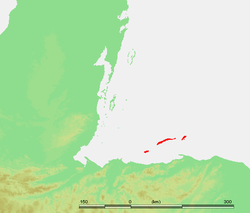Bay Islands Department
|
Bay Islands Departamento Islas de la Bahía |
|
|---|---|
 |
|
| Coordinates: 16°17′27″N 86°24′39″W / 16.29083°N 86.41083°WCoordinates: 16°17′27″N 86°24′39″W / 16.29083°N 86.41083°W | |
| Country | Honduras |
| Largest city | Roatan |
| Area | |
| • Total | 250 km2 (100 sq mi) |
| Population (2015) | |
| • Total | 65,932 |
| • Density | 260/km2 (680/sq mi) |
The Bay Islands (Spanish: Islas de la Bahía; pronounced: [ˈizlaz ðe la βaˈi.a]) is a group of islands off the coast of Honduras. Collectively, the islands form one of the 18 Departments of Honduras. The departmental capital is Roatan, on the island of Roatán.
The total surface area of the islands is 250 km2. In 2013, they had an estimated population of 71,500 people. The islands comprise three separate groups:
The Bay Islands consist of eight islands and 53 small cays lying 15 kilometres (10 mi) to 60 kilometres (40 mi) off the northern coast of Honduras. These islands have been administered as a department of the Republic of Honduras since 1872. Located on the Caribbean Sea, not far east of the entrance to the Gulf of Honduras, they are clearly visible from the mountainous mainland.""The group is made up of the three large islands, Utila, Roatan, and Guanaja, and the smaller islands, or island groups, St. Helena, Barbareta, Morat, and, closest to the mainland, the two Hog Islands (Cayos Cochinos).
Roatan is the largest with a length of about 60 kilometres (40 mi) and a maximum width of 14 kilometres (9 mi) at its widest point. Roatán, is characterized by its mountainous backbone, composed of hilltops that run west-to-east across the entire island. These hilltops are often crowned by outcrops of exposed metamorphic rocks such as marble, amphibolite, and serpentine.
The island's southern coast has an abundance of deep ports and wide inlets, or 'bights', protected by reefs, while its northern coast is, save for a few narrow passages, largely inaccessible due to extensive coral reef growth.
The island of St. Helene has been described as a virtual extension of Roatán, since it is separated only by a long stretch of mangrove swamp. This island has a small elevated hill at its center, but is characterized by a large number of caves, most of which are located along a cliff on its western end.
Guanaja is the second largest and is even more mountainous than Roatan. "Guanaja presents a mixture of thetopographic and geologic features that characterize the two other large islands. This island is roughly divided into three sections by a series of hilltops, the highest of which rises to over 350 m above sea level, the highest elevation of the Bay Islands. These hilltops include important deposits of granite, marble, and serpentine." "In between these hills are moderately-sized alluvial plains that cut across these deposits, which have been densely populated since prehistory."
...
Wikipedia
